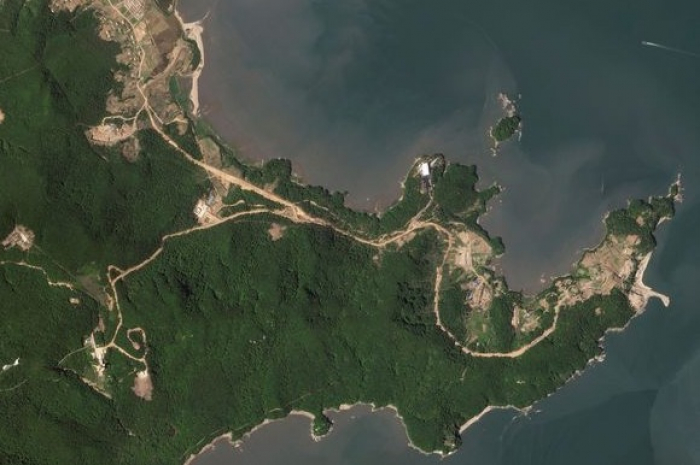North Korean spy satellite fails to reach space
Pyongyang vows to conduct another reconnaissance satellite launch near future
By The Wall Street Journal May 31, 2023 (Gmt+09:00)
LG Chem to sell water filter business to Glenwood PE for $692 million


Kyobo Life poised to buy Japan’s SBI Group-owned savings bank


KT&G eyes overseas M&A after rejecting activist fund's offer


StockX in merger talks with Naver’s online reseller Kream


Mirae Asset to be named Korea Post’s core real estate fund operator



SEOUL -- North Korea’s first military satellite crashed into the Yellow Sea and failed to launch into space, Pyongyang’s state media said, a test that triggered emergency alerts in South Korea and Japan.
North Korea launched a rocket carrying a military satellite around 6:27 a.m. local time from the Sohae Satellite Launching Station, the country’s state media said hours later. But the second stage of the rocket malfunctioned, causing it to crash into the waters between China and the Korean Peninsula. Pyongyang will conduct another launch in the near future, the report said.
The Wednesday launch spurred early-morning confusion in the South Korean capital of Seoul—a city of roughly 10 million people—as air-raid sirens blared and residents received an emergency text recommending people to prepare for a potential evacuation. South Korea’s Ministry of the Interior and Safety later said that guidance had been a false alert.
Seoul’s military said that Pyongyang had fired a “space-launch vehicle” that flew irregularly and fell into waters about 124 miles off South Korea’s western island of Eocheong.
Construction had been taking place at the Sohae launch site in recent months, and, based on satellite imagery from Tuesday, vehicles that could transport elements of the space-launch vehicle or fuel oxidizer tanks were spotted, according to a report by the Center for Strategic and International Studies, a Washington, D.C.-based think tank. The launch site, located in the country’s northwest, has been used to conduct satellite launches and Pyongyang’s first solid-fuel engine test.
Only a limited group of nations, including the U.S., China and Russia, possess advanced satellite capabilities given the technical hurdles. Neighboring South Korea last week cleared a key advancement, sending eight satellites into space with plans to launch its first reconnaissance satellite in November.
Such efforts have long bedeviled North Korea. Several attempts have failed, including in 2012, when North Korea launched a multistage rocket that blew up less than two minutes into flight and had parts crash into the Yellow Sea. Later that year the Kim Jong Un regime successfully placed a satellite into space. Then, in 2016, it did so again, though the pair of satellites that are orbiting Earth are considered nonfunctional because they cannot transmit any data back.
North Korea’s 39-year-old dictator has said spy-satellite technology was crucial in countering the U.S. and South Korea. The military reconnaissance satellite was one of Kim’s pursuits in the five-year weapons strategy revealed in January 2021. He was photographed by state media examining the hexagon-shaped spy satellite earlier this month.
On Wednesday morning, the South Korean government did maintain a warning for citizens near Baekryeong island, the western most of five South Korea-controlled islands near the inter-Korean maritime border. The space vehicle flew over western seas near the island, Seoul’s military said. Japanese authorities issued evacuation warnings in Okinawa, initially characterizing North Korea’s launch as a missile test.
Pyongyang had earlier told the Japanese government and the International Maritime Organization that a launch could occur between May 31 and June 11. North Korea said it expected the satellite debris to fall over the Yellow Sea and into the Pacific Ocean.
The U.S. and South Korea have conducted a series of joint military drills this year, which require North Korea to obtain the “means capable of gathering information about the military acts of the enemy in real time,” said Ri Pyong Chol, a senior North Korean military official, in state media on Tuesday. Ri justified the coming satellite launch as a response to the “dangerous military acts” of Washington and Seoul.
In recent days, the U.S., South Korea and Japan have said North Korea would face a firm response for its satellite launch. The United Nations Security Council bans Pyongyang’s satellite launches, which overlap with long-range missile technology. Japan’s defense minister ordered the military to prepare destructive measures against any missile debris that could fall in Japanese territory.
South Korean President Yoon Suk Yeol called a security meeting to discuss North Korea’s Wednesday launch.
North Korea has launched missiles roughly a dozen times this year, including cruise missiles from a submarine and a solid-fuel intercontinental ballistic missile. North Korea has characterized joint military drills between the U.S. and its allies as a rehearsal for invasion and pointed to them as reasons for carrying out further weapons tests. Pyongyang hasn’t conducted a missile launch since April.
Write to Dasl Yoon at dasl.yoon@wsj.com
-

-
 North KoreaNorth Korea Barrages south with missiles; South Korea swiftly responds
North KoreaNorth Korea Barrages south with missiles; South Korea swiftly respondsNov 03, 2022 (Gmt+09:00)
6 Min read -
 North KoreaNorth Korea dismisses South Korea’s move to improve ties as ‘absurd dream’
North KoreaNorth Korea dismisses South Korea’s move to improve ties as ‘absurd dream’Aug 23, 2022 (Gmt+09:00)
4 Min read -
 North KoreaNorth Korea missile tests drawing tougher response from US, South Korea
North KoreaNorth Korea missile tests drawing tougher response from US, South KoreaJun 13, 2022 (Gmt+09:00)
4 Min read -
 North KoreaNorth Korea fires three missiles after Biden ends Asia trip
North KoreaNorth Korea fires three missiles after Biden ends Asia tripMay 26, 2022 (Gmt+09:00)
3 Min read


